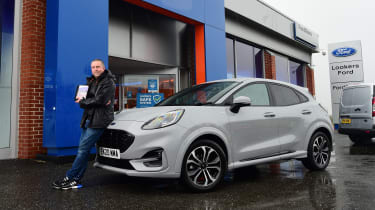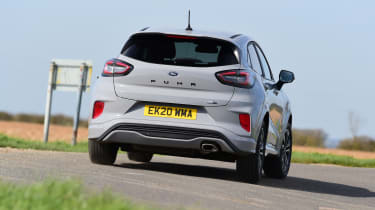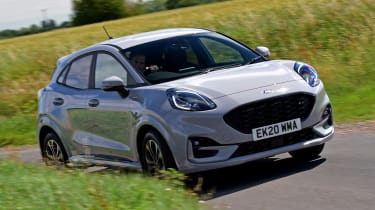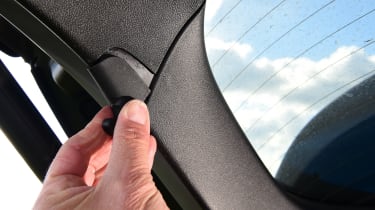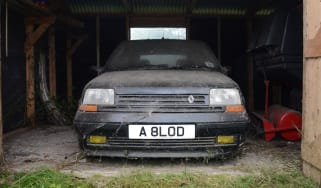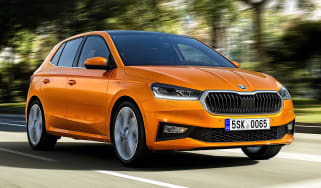Ford Puma ST-Line: long-term test review
Second report: Ford Puma compact SUV checks in for first service
Verdict
The Puma has been piling on the miles, but taking it all in its stride. We love the way it drives, its darty nature and strong refinement on the motorway. It’s another cracking crossover from Ford.
- Mileage: 20,516
- Economy: 43.8mpg
Until last year, life for cars on the Auto Express fleet was usually busy and demanding. We’d pile on thousands of miles travelling up and down the country – and even into mainland Europe – for events.
Yet, although almost everyone else on the Auto Express team has left their car sitting on their drive recently, rarely travelling further than the local supermarket, things haven’t changed much for me.
As Auto Express’ resident snapper, I’ve still had the opportunity to travel for work, shooting our famous road tests all over the country. The result is that, unlike other cars on the fleet, my Puma has clocked up more than 20,000 miles over the past year. And it’s been a fantastic companion.
The Puma needed its first service at 17,700 miles, with the oil-change symbol on the dash lighting up to tell me it was due.
Given Covid limitations and a busy schedule, the Puma was finally given its service with 19,161 miles on the clock. The nearest Ford dealership to where I live is Lookers in Chelmsford; a quick call and the car was booked in with a few days’ notice.
Now with fresh oil and after a general health check, the car feels back to its best. The Puma is nippy and agile for a crossover, but is also a great motorway drive. What still impresses me about the Ford is the amount of torque from its tiny 1.0-litre engine. Even when it’s loaded up with all my camera gear the Puma has a great turn of pace and the engine pulls really strongly right up to the top end. It does create a noticeable amount of noise in the lower gears, but it’s easy to forgive this for the overall package.
More reviews
Generally the Puma is a great bit of kit, but living with the car and working it hard have highlighted a few small issues for me. Thanks to the small 42-litre fuel tank, the driving range is only just over 400 miles, which can often be less than half my weekly mileage. But this is obviously a very specific problem for my role because most people would find that range more than enough to live with on a day-to-day basis.
So let’s call that a minor niggle, but one thing that I can’t forgive is the rear parcel shelf. It might sound silly, but I’m always in and out of the boot getting camera gear, and often getting in the boot to take pictures, so the flimsy parcel shelf is a real nuisance.
It not only feels cheap, but the material that’s used to attach it to the boot lid itself is equally flimsy, and this has led to a piece breaking off. I’m sure it’s an easy part to replace, but I don’t understand the need to cut costs on things that will be used a lot in a car’s life.
Ford Puma ST-Line: first report
It’s so far, so good for the Puma. We love that it drives like a small Ford should – it’s feisty and enjoyable – but it’s the practicality in a small package that has really impressed us. Our man says it’s exactly what he needs from a car to fit his lifestyle.
- Mileage: 7,198
- Economy: 31.8mpg
No sooner have I said farewell to one fleet car than I’m welcoming its replacement – and I’m really excited about this one, because the Ford Puma is most definitely my kind of car.
Don’t get we wrong, I got on well with my Mazda 3, but I like small SUVs and the style they offer, so that was the first thing that drew me to the Puma. Of course, Ford’s nameplate was known as a small coupé back in the nineties, but fashions change, and while compact two-doors were popular then, now people want SUVs.
It’s easy to see why with the Puma, because it looks great. Let’s touch a little on why. This £23,740 ST-Line version looks slightly sportier, with its 17-inch alloys, while the £750 Grey Matter Exclusive paint certainly suits the curvy bodywork, but that’s quite a lot to pay when other colours look just as good and are cheaper.
Fundamentally, though, the Ford nails the proportions a small SUV needs to have, and underneath that stylish cloak the car is based on the same platform and uses the same mechanicals as the current Fiesta, so it’s great to drive as well. It’s also a versatile piece of kit for its size, as I’ve already found out.
My photography equipment spilled over into the cabin with the Mazda 3, but thanks to the Puma’s clever MegaBox storage compartment under the boot floor, the 68-litre void will easily take my portable pressure washer and a five-litre tub of water. I can chuck my kids’ muddy shoes in there, too, and then remove the drain plug and hose the area out. It’s a very useful touch.
Once I’ve put the boot floor down and filled the total 456 litres available (which is not a bad size for a small SUV), it will easily take my camera bag, tripod, flash stands, cleaning gear, harness – the list goes on.
What that means is that the cabin is kept free of this clutter. There’s enough space in the back because being sat slightly higher up than in a hatch means the seats can be raised and your legs brought back closer to you. It’s a clever trick, because the Puma is still a compact car, at 4.2 metres long.
It’s this trait that I’ve been enjoying since I took custody of the Ford, too, because the lack of overhangs and that platform underneath mean it drives as well as any small SUV I’ve been in. The steering is sharp, there’s plenty of agility and it just feels fun.
I’m not totally sold on the engine, though. This 153bhp 1.0-litre EcoBoost unit is a bit drummy until you’re cruising, and even with mild-hybrid assistance, the Puma has only been averaging around 32mpg so far.
There’s also a small jolt when coming on and off the throttle as the integrated belt starter generator cuts in and out to either provide a small dump of torque or recharge the mild-hybrid system’s tiny battery.
However, these minor niggles are the only few things I’ve found after spending a lot of time in the Puma recently. My first impressions have been overwhelmingly positive, as have my wife’s. She’s a better judge than me on matters regarding style, and she likes it, so it’s a thumbs up there.
Other factors I like? Well, the digital dash is a nice tech touch and complements the eight-inch infotainment screen well. The system is great, responds rapidly and looks slick for the money, I think, and although my creaking Samsung phone is a bit old and slow for Android Auto, it’s nice to know the car has this and Apple CarPlay connectivity, because my two girls both have iPhones, so we can listen to their tunes.
| Model: | Ford Puma 1.0 EcoBoost mHEV 155 ST-Line |
| On fleet since: | May 2020 |
| Price new: | £23,740 |
| Engine: | 1.0-litre 3cyl turbo petrol mild-hybrid, 153bhp |
| CO2/tax: | 128g/km/£150 |
| Options: | Exclusive paint (£750), privacy glass (£250), Comfort pack (£300), powered tailgate (£600) |
| Insurance*: | Group: 14 Quote: £441 |
| Mileage/mpg: | 20,516/43.8mpg |
| Any problems? | Parcel shelf hook snapped off |
*Insurance quote from AA (0800 107 0680) for a 42-year-old in Banbury, Oxon, with three points.

